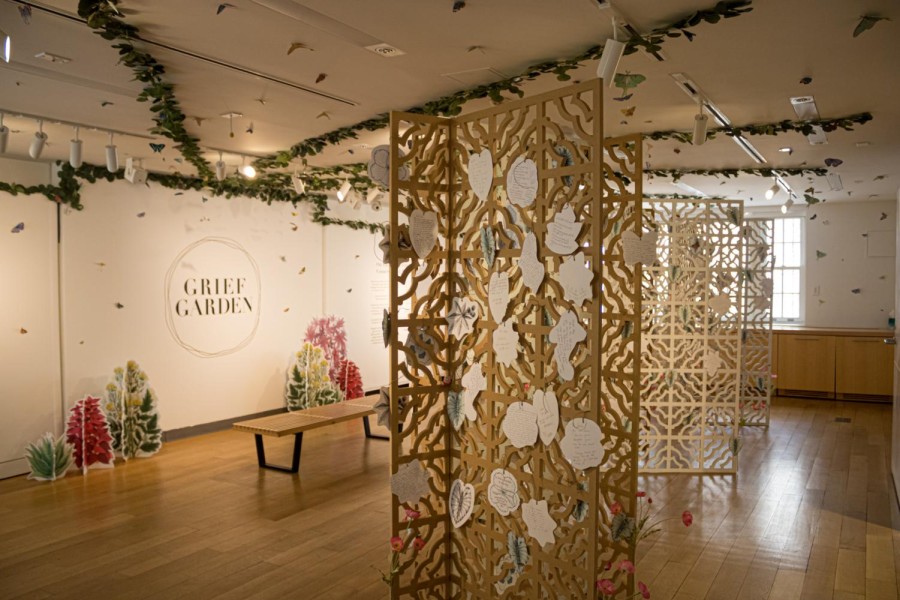Reflecting on life and love at the ‘Grief Garden’
Artist-in-Residence Khaty Xiong’s poetry installation at the Asian/Pacific/American Institute offers those grieving a place of solace and comfort.
Curated by 2022 Spring Artist-in-Residence Khaty Xiong, “Grief Garden” is an exhibition about collective meditation on grief based on an eponymous poem. (Photo by Gabe Vasconcellos)
April 29, 2022
Grief arrives differently for everyone. It’s sometimes expected, other times sudden, but never without impact. Whether it strikes, constricts or swallows, loss produces all-consuming feelings of isolation and loneliness. In the immersive poetry installation, “Grief Garden,” 2022 Spring Artist-in-Residence Khaty Xiong challenges the notion that grief is a solitary experience. I had the chance to speak with Xiong about her poem, the installation and her relationship with grief.
Located on the first floor of the Asian/Pacific/American Institute, the installation fills a spacious room. Her 2017 poem “On Visiting the Franklin Park Conservatory & Botanical Gardens” is displayed, and it centers around a very private experience. The installation’s design takes this personal loss and calls us to acknowledge grief publicly.
Visitors first observe three patterned trellises in a row carrying dozens of handwritten messages to people loved and lost. These letters, written by previous visitors, are on full display. Newcomers are encouraged not only to read them but to add their own. The paper templates, designed by Megan Liao and Nathan Kawanishi, have elegant flowers imprinted on one side that mimic those seen in the Franklin Park Conservatory in Columbus, Ohio. Xiong wrote her poem there following her mother’s burial.
“My mother was a shaman and a medicine woman, so the garden was a very sacred place for her, and the conservatory is its own garden, as well,” Xiong said. “Even before my mom passed, I found myself visiting the Franklin Park Conservatory a lot, and it was after she passed that I felt this need to write a poem in response to how I was feeling, the confusion in her loss.”
The installation has vibrant butterflies scattered across the white wall and carefully crafted leaves and plants on the ceiling and floor, flora that is reminiscent of Xiong’s mother. Xiong’s poem resides on the back wall of the installation accompanied by a barcode on the left that brings readers to a recording of her reciting the piece.
“It’s a poem that is about such a personal loss in my life,” Xiong said. “But, I was thinking, it’s going to be brought to a scale where it’s no longer a private grieving in my life. It will be in the public where I am inviting others who have lost those as well in their life to come and think collectively about profound loss and complicated grief.”
Many letters echo this sentiment, as people write about the conversations they wish they could have and words left unsaid. “Grief Garden” creates a space for reflection and setting down the heaviness that often accompanies grief and grips those affected. With soft yellow light, gentle gong sounds courtesy of Grace Osborne and Gabriel Andruzzi, and overall warmth to the room, visitors are provided comfort and quiet as they sink into grief and allow themselves to fully experience it.
“‘Grief Garden’ was the first of its kind I ever experienced for myself,” Xiong said. “As a writer, I never imagined I would be involved in any kind of curated scenario where my poem is featured in some kind of way.”
Xiong’s project first came about in 2018 when Lawrence-Minh Bùi Davis from the Smithsonian Asian Pacific American Center and Fred Sasaki from the Poetry Foundation reached out to her about creating an immersive poetry installation. “Grief Garden” was expected to appear in NYU’s Asian/Pacific/American Institute Gallery in 2020 but was canceled due to COVID-19. In 2021, Xiong was asked to revive the collaboration and invited to be the 2022 Spring Artist-in-Residence.
“I was very flattered and also overwhelmed because I thought, okay, this is different now,” Xiong said. “I’m not just a guest coming in to showcase my work. To be the Spring Artist-in-Residence was a designation and an honor I’m still having a hard time processing. They’ve been so good to me and the process has been so beautiful.”
While Xiong noted that there are virtually no differences between NYU’s version of the installation and the Poetry Foundation’s, she did acknowledge one change.
“I asked one of the artists, Megan Liao, if they could draw and contribute plants from my mom’s garden, because at the time we were putting this together I was really missing my mom,” Xiong said. “I thought, what would it look like if I walked into a garden space where it really did feel like a snippet, like a small slice of my memory of what that garden looked like?”
Liao is an NYU Steinhardt alum who contributed to the installation design. The floral arrangements both shape the environment and emulate the peace and relief felt in gardens. From the greenery dispersed throughout the room to the letters that range in language and length, “Grief Garden” holds the warmth and consolation of an embrace. The love and safety this installation extends is an effort that NYU’s community and the city at large should cherish. Visit “Grief Garden” at 8 Washington Mews from 12 p.m. to 5 p.m. from Monday through Friday.
Email Sunny Sequeira at [email protected].
























































































































































